Pink birds are some of the most beautiful and unique creatures in the animal world. Their bright, soft pink feathers make them stand out, and they can be found in different parts of the world. These birds are not only known for their color but also for their graceful movements and interesting behaviors. In this article, we will explore some popular pink bird species and learn more about where they live, what they eat, and why they are special.
10 Pink Birds
Here are 10 beautiful pink birds you can find in nature:
- Flamingo – Known for their long legs and bright pink feathers.
- Roseate Spoonbill – A wading bird with a pink body and a spoon-shaped bill.
- Pink Robin – A small bird with a soft pink chest found in Australia.
- Pink Cockatoo – Also called Major Mitchell’s Cockatoo, it has pale pink feathers and a colorful crest.
- Hawaiian Honeycreeper – Some species have pink feathers, and they live in Hawaii.
- Scarlet Ibis – Though mostly red, this bird sometimes has pink shades in its feathers.
- Galah – A type of cockatoo with pink and gray feathers, commonly found in Australia.
- Andean Flamingo – A rare pink flamingo found in the Andes mountains.
- Rose-breasted Cockatoo – Another cockatoo with a bright pink chest and gray wings.
- Pink-headed Fruit Dove – Found in Southeast Asia, it has a pink head and colorful body.
10 Pink Birds: A Guide to Nature’s Most Beautiful Birds
Pink birds are a remarkable sight in nature. Their soft, vibrant, and often striking pink feathers make them stand out in a world of greens and browns. These birds live in a variety of habitats and have adapted to different environments, from rainforests to wetlands. In this detailed guide, we will explore ten of the most fascinating pink birds, looking at their characteristics, habitats, diets, and unique behaviors. Through these descriptions, you’ll gain a greater appreciation for these birds and the role they play in nature.
1. Flamingo: The Most Famous Pink Bird
Flamingos are probably the most well-known pink birds in the world. They are large, graceful creatures, famous for standing on one leg and their bright pink feathers.
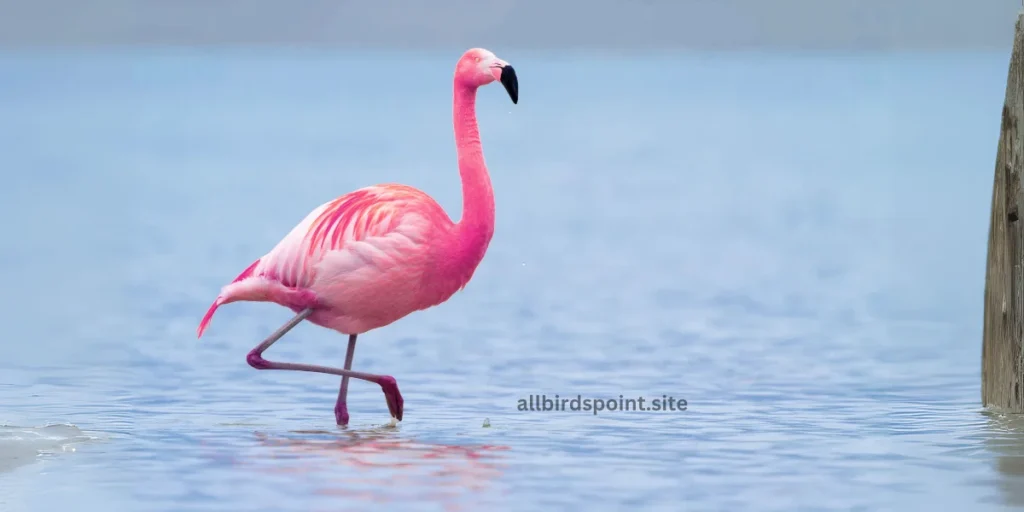
Appearance
Flamingos are tall birds with long, slender legs, an equally long neck, and a hooked beak that is used to filter food from the water. The shade of pink in their feathers can vary from light pink to almost red, depending on their diet. Young flamingos are usually gray or white, and they develop their pink color over time.
Habitat
Flamingos are found in tropical and subtropical regions around the world. You can find them in parts of Africa, the Americas, the Caribbean, and even in southern Europe. They thrive in large, shallow lakes, salt flats, and lagoons where there is plenty of food.
Diet
Their diet mainly consists of algae, small crustaceans, and plankton. The pigments in the algae and crustaceans they eat (called carotenoids) are what give flamingos their famous pink color.
Interesting Fact
Flamingos often stand on one leg, and no one is quite sure why. Some researchers think it helps them conserve body heat, while others believe it’s simply more comfortable for them.
| Feature | Information |
|---|---|
| Scientific Name | Phoenicopterus |
| Lifespan | 20-30 years in the wild, up to 50 years in captivity |
| Size | 1.1 to 1.5 meters (3.6 to 4.9 feet) tall |
| Weight | 2 to 4 kg (4.4 to 8.8 lbs) |
| Diet | Algae, crustaceans, plankton |
| Habitat | Shallow lakes, lagoons, wetlands |
| Region | Africa, Americas, Southern Europe |
| Coloration | Pink due to carotenoids in their diet |
2. Roseate Spoonbill: The Bird with the Spoon-Shaped Bill
The Roseate Spoonbill is a large wading bird known for its unique spoon-shaped bill and its beautiful pink feathers. It’s not as famous as the flamingo but is equally fascinating.
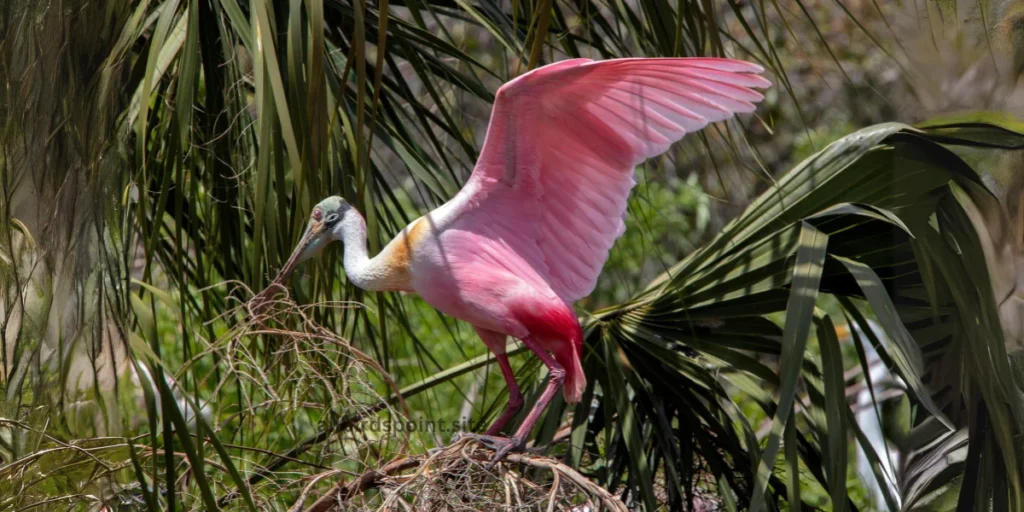
Appearance
Roseate Spoonbills have a long, flat bill that is shaped like a spoon at the tip. Their feathers are a mixture of pale pink and deeper rose pink, with some white feathers on their wings. The deeper the pink color, the healthier the bird usually is.
Habitat
These birds are found in wetlands, marshes, and coastal lagoons in the southeastern United States, the Caribbean, and Central and South America. They prefer areas with shallow water where they can wade and search for food.
Diet
Roseate Spoonbills eat small fish, shrimp, and aquatic insects. They use their spoon-shaped bill to sift through the water and mud, sweeping their head from side to side to catch their prey.
Interesting Fact
Unlike most birds, Roseate Spoonbills get their food by touch, not sight. Their bill is very sensitive, allowing them to detect prey in muddy water even if they can’t see it.
| Feature | Information |
|---|---|
| Scientific Name | Platalea ajaja |
| Lifespan | 10-15 years in the wild |
| Size | 71-86 cm (28-34 inches) |
| Weight | 1.2 to 1.8 kg (2.6 to 3.9 lbs) |
| Diet | Small fish, crustaceans, insects |
| Habitat | Wetlands, mangroves, lagoons |
| Region | Southeastern U.S., Central and South America, Caribbean |
| Coloration | Pale pink to rose, with white feathers on wings |
3. Pink Robin: A Small Bird with a Splash of Pink
The Pink Robin is one of the smaller birds on our list but is no less striking. Found only in Australia, this bird’s bright pink chest contrasts beautifully with its dark feathers.
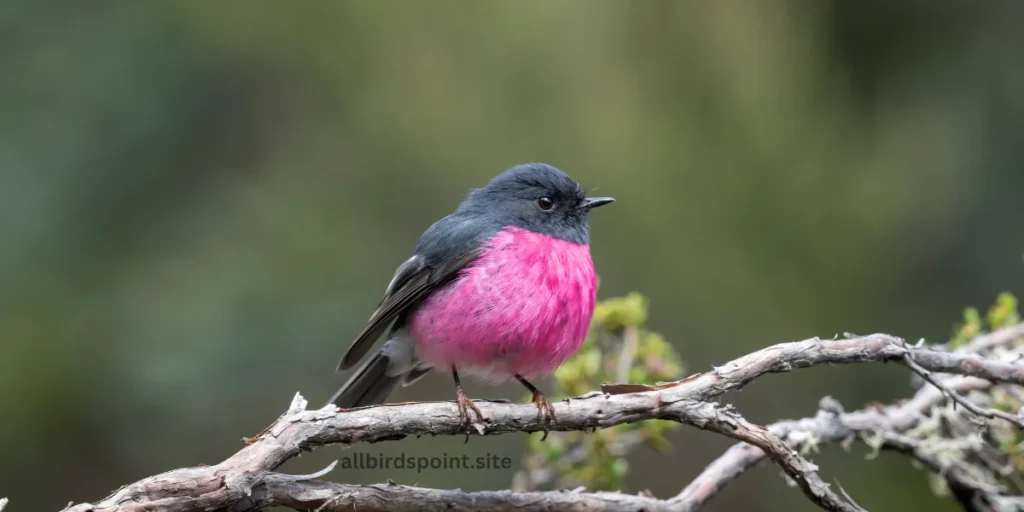
Appearance
Male Pink Robins are the more colorful of the species, with black feathers on their head and back and a bright pink chest and belly. Females are a bit more subdued in appearance, with grayish-brown feathers and a lighter pinkish-buff on their undersides. Despite their small size, they are eye-catching because of their bright coloring.
Habitat
These birds are found in southeastern Australia, particularly in the dense, wet forests of Tasmania and Victoria. They prefer cooler, more humid environments.
Diet
Pink Robins feed primarily on insects, including spiders, beetles, and caterpillars. They hunt for food by flying through the air or foraging through leaves on the ground.
Interesting Fact
Even though they have bright feathers, Pink Robins are difficult to spot in the wild because they live in thick forests and move quickly through the trees.
| Feature | Information |
|---|---|
| Scientific Name | Petroica rodinogaster |
| Lifespan | 2-5 years in the wild |
| Size | 12-14 cm (4.7-5.5 inches) |
| Weight | 9 to 11 grams |
| Diet | Insects (spiders, beetles, caterpillars) |
| Habitat | Rainforests, dense forests |
| Region | Southeastern Australia, Tasmania |
| Coloration | Males: black with a bright pink chest, Females: brownish |
4. Pink Cockatoo : The Elegant Parrot
Major Mitchell’s Cockatoo, commonly known as the Pink Cockatoo, is one of the most beautiful parrots in the world. It is known for its soft pink coloring and striking crest.

Appearance
The Pink Cockatoo has a light pink body, with white feathers on its wings and tail. Its most unique feature is its head crest, which is colored with bright pink, yellow, and orange. The crest is used to communicate excitement, fear, or curiosity.
Habitat
These cockatoos are native to Australia, where they live in arid and semi-arid areas such as woodlands, scrublands, and grasslands. They are more commonly found in the inland regions of the country, where they nest in hollow trees.
Diet
Pink Cockatoos eat seeds, fruits, and nuts. They are often seen foraging on the ground, searching for food. They are also known to feed on crops in farming areas, sometimes causing conflicts with farmers.
Interesting Fact
Pink Cockatoos are highly social and intelligent birds. In the wild, they live in small flocks, and they often pair up with a mate for life. Their loud, screeching calls can be heard from a long distance away.
4. Pink Cockatoo (Major Mitchell’s Cockatoo)
| Feature | Information |
|---|---|
| Scientific Name | Lophochroa leadbeateri |
| Lifespan | Up to 60 years in captivity, around 40 years in the wild |
| Size | 35-40 cm (14-16 inches) |
| Weight | 350-500 grams |
| Diet | Seeds, fruits, nuts, grains |
| Habitat | Woodlands, arid regions, scrublands |
| Region | Australia |
| Coloration | Light pink body with colorful crest (pink, yellow, orange) |
5. ʻIʻiwi (Hawaiian Honeycreeper): The Jewel of Hawaii
The ʻIʻiwi, a member of the Hawaiian honeycreeper family, is a stunning bird that plays a vital role in the ecosystem of the Hawaiian Islands.
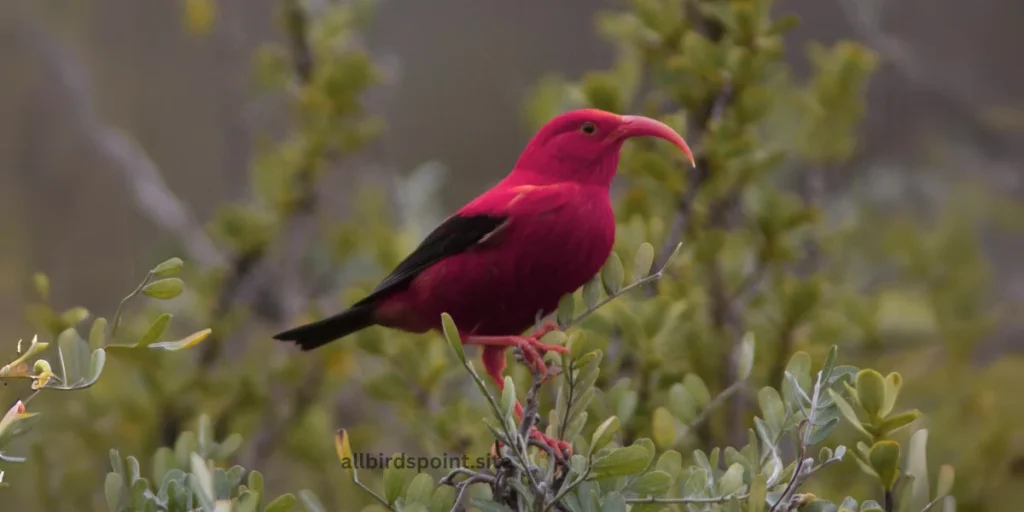
Appearance
The ʻIʻiwi is a small bird with striking pink-red feathers, a long, curved beak, and black wings. The bright color of their feathers makes them look like jewels flying through the forest. Their curved beak is perfectly adapted for drinking nectar from flowers.
Habitat
These birds are found in the higher elevations of the Hawaiian Islands, especially in dense rainforests where native flowering plants grow. They are now rare in the lower elevations due to habitat destruction and the introduction of invasive species.
Diet
The ʻIʻiwi’s primary food source is nectar from native Hawaiian flowers like the ʻōhiʻa lehua. They play an important role in pollinating these flowers as they move from plant to plant.
Interesting Fact
The ʻIʻiwi’s long, curved beak is perfectly designed to match the shape of the flowers they feed on. Unfortunately, the destruction of native plants and competition from invasive species have caused a decline in their population.
| Feature | Information |
|---|---|
| Scientific Name | Drepanis coccinea |
| Lifespan | 10 years in the wild |
| Size | 15 cm (6 inches) |
| Weight | 16 to 20 grams |
| Diet | Nectar, some insects |
| Habitat | Rainforests at high elevations |
| Region | Hawaiian Islands |
| Coloration | Pink-red feathers, black wings |
6. Scarlet Ibis: A Red Bird with a Touch of Pink
The Scarlet Ibis is a bird with striking red feathers, although sometimes they can appear pink depending on their diet and age.
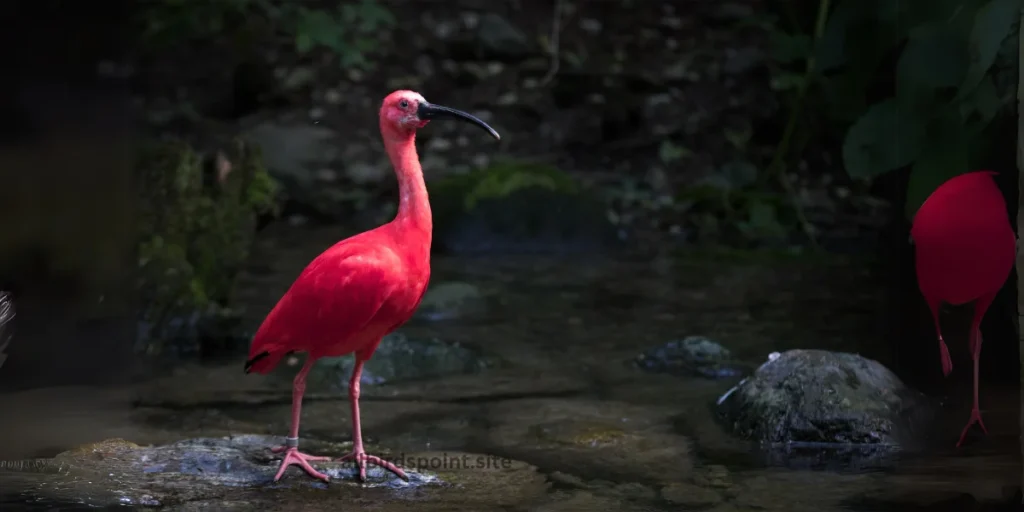
Appearance
This bird has brilliant red feathers all over its body, which can appear pinkish at times. Its long, curved bill is used for foraging in shallow water. The red color comes from the carotenoid pigments found in the crustaceans they eat, similar to flamingos.
Habitat
Scarlet Ibises are found in coastal wetlands, mangroves, and mudflats in South America and the Caribbean. They thrive in shallow waters where they can easily find food.
Diet
Their diet consists of small fish, crustaceans, and insects. As with flamingos, the red and pink color in their feathers comes from the carotenoids in their food.
Interesting Fact
Scarlet Ibises often nest in large colonies with other wading birds. They are highly social and can sometimes be seen flying in large flocks with synchronized movements.
| Feature | Information |
|---|---|
| Scientific Name | Eudocimus ruber |
| Lifespan | 16-20 years in the wild |
| Size | 56-61 cm (22-24 inches) |
| Weight | 1 to 1.4 kg (2.2 to 3 lbs) |
| Diet | Small fish, crustaceans, insects |
| Habitat | Mangroves, wetlands, mudflats |
| Region | South America, Caribbean |
| Coloration | Scarlet red, sometimes with pink hues |
7. Galah: The Common Pink Cockatoo of Australia
The Galah is a familiar bird in Australia, easily recognized by its pink and gray feathers. It is one of the most widespread cockatoos in the country.

Appearance
The Galah has a light pink head and chest, with gray wings and back. Like other cockatoos, it has a short crest that it raises when excited or alarmed. The Galah is smaller than the Major Mitchell’s Cockatoo, but just as eye-catching.
Habitat
Galahs are widespread throughout Australia and are often found in open woodlands, grasslands, farmlands, and even urban areas. They have adapted well to human environments and can often be seen in parks and gardens.
Diet
Galahs primarily eat seeds, fruits, and grains. They are known to forage on the ground in large groups, especially in farming areas where they feed on crops.
Interesting Fact
Galahs are highly social birds, often forming large flocks that can number in the hundreds. They are playful and intelligent, and they are known for their loud calls.
| Feature | Information |
|---|---|
| Scientific Name | Eolophus roseicapilla |
| Lifespan | 40 years in captivity, around 25-30 years in the wild |
| Size | 35-38 cm (14-15 inches) |
| Weight | 270-350 grams |
| Diet | Seeds, grains, fruits |
| Habitat | Open woodlands, grasslands, urban areas |
| Region | Australia |
| Coloration | Pink chest and head, gray wings and back |
8. Andean Flamingo: A High-Altitude Pink Flamingo
The Andean Flamingo is one of the rarest flamingos in the world and is known for its pale pink feathers and distinctive black markings.
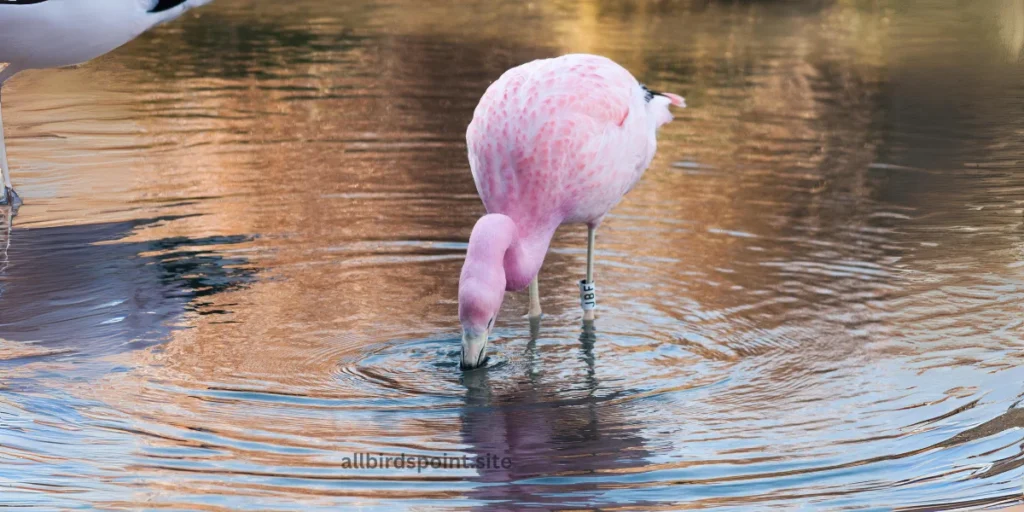
Appearance
The Andean Flamingo has a light pink body with black-tipped wings and tail. Its long legs are yellow, which is unique among flamingo species. The Andean Flamingo is slightly smaller than other flamingo species, but it has the same elegant, long-legged appearance.
Habitat
As its name suggests, this flamingo is found in the high-altitude salt flats and lakes of the Andes mountains in South America, particularly in countries like Chile, Argentina, and Bolivia. They live at altitudes of up to 4,000 meters, where the environment is harsh and cold.
Diet
The Andean Flamingo feeds on algae, small crustaceans, and diatoms, which give it its pink color. They are filter feeders, using their specialized beaks to strain food from the water.
Interesting Fact: The Andean Flamingo is considered a vulnerable species due to habitat loss and declining populations. Conservation efforts are underway to protect their breeding grounds.
| Feature | Information |
|---|---|
| Scientific Name | Phoenicoparrus andinus |
| Lifespan | 40 years in the wild |
| Size | 1 to 1.4 meters (3.2 to 4.6 feet) |
| Weight | 2 to 3.5 kg (4.4 to 7.7 lbs) |
| Diet | Algae, diatoms, small crustaceans |
| Habitat | High-altitude salt lakes and wetlands |
| Region | Andes Mountains (South America) |
| Coloration | Pale pink with black-tipped wings and yellow legs |
9. Rose-breasted Cockatoo: Another Name for the Galah
The Rose-breasted Cockatoo is another name for the Galah, which we have already discussed. This bird is known for its playful nature and its striking pink and gray feathers.
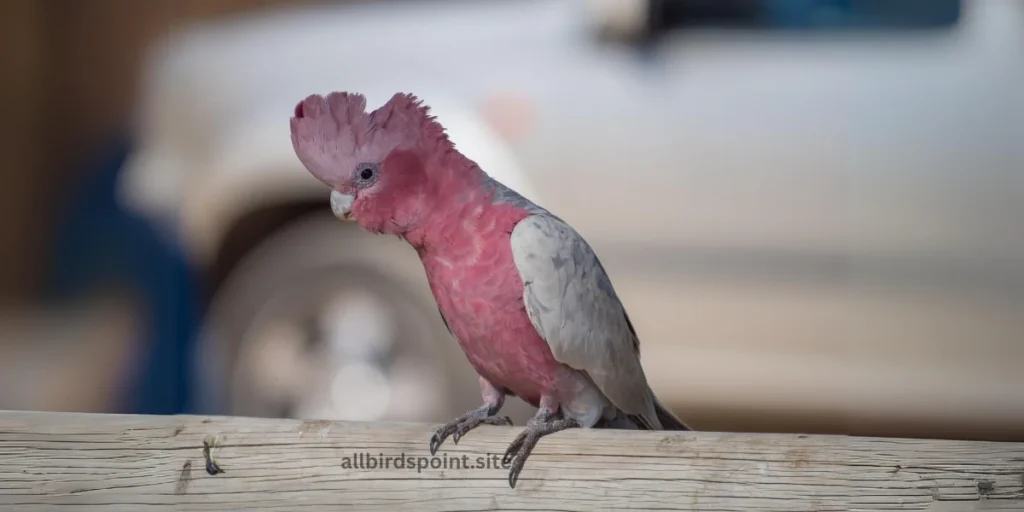
Appearance
The Rose-breasted Cockatoo, or Galah, has a bright pink chest and belly, with gray wings and back. It has a short, pointed crest that it can raise when alarmed or excited.
Habitat
This cockatoo is found throughout Australia, where it is common in woodlands, grasslands, and urban areas. It is highly adaptable and can thrive in a variety of environments.
Diet
Like other cockatoos, the Rose-breasted Cockatoo feeds on seeds, nuts, and fruits. It is often seen foraging on the ground in large flocks.
Interesting Fact
The Rose-breasted Cockatoo is known for its intelligence and playfulness. They are often kept as pets because of their friendly nature and ability to mimic sounds and words.
| Feature | Information |
|---|---|
| Scientific Name | Eolophus roseicapilla |
| Lifespan | 40 years in captivity, 25-30 years in the wild |
| Size | 35-38 cm (14-15 inches) |
| Weight | 270-350 grams |
| Diet | Seeds, grains, fruits |
| Habitat | Open woodlands, grasslands, urban areas |
| Region | Australia |
| Coloration | Pink chest and head, gray wings and back |
10. Pink-headed Fruit Dove: A Colorful Bird of the Rainforest
The Pink-headed Fruit Dove is a beautiful bird with a unique pink head, found in the tropical rainforests of Southeast Asia.
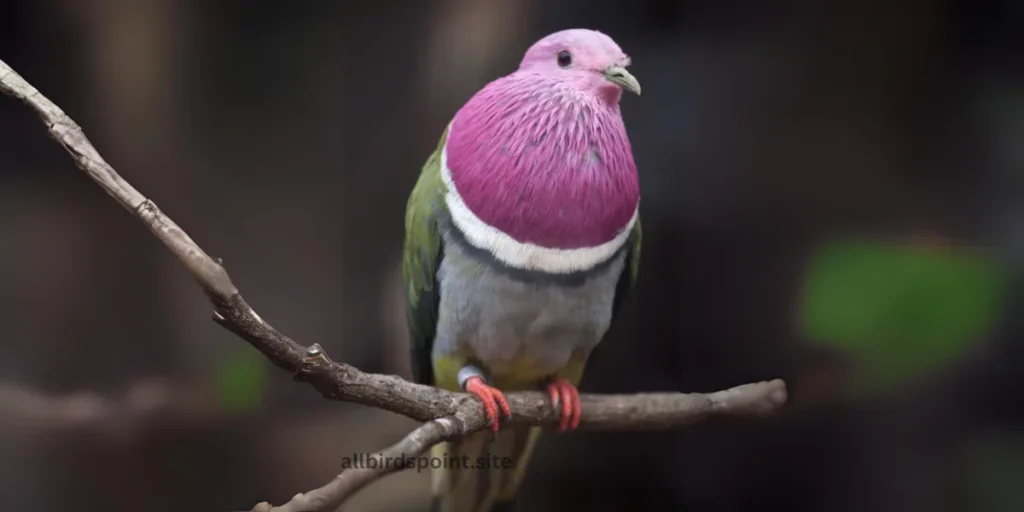
Appearance
This dove has a bright pink head and neck, with a green body and wings. Its feathers are soft and blend in well with the surrounding foliage. The pink and green combination makes it one of the most striking birds in the forest.
Habitat
The Pink-headed Fruit Dove is found in the rainforests of Southeast Asia, including countries like Indonesia, Malaysia, and the Philippines. They live in the lower and mid-levels of the forest, where they can easily find food.
Diet
As the name suggests, these doves primarily feed on fruit, especially figs and berries. Their diet helps to scatter seeds throughout the forest, playing an important role in maintaining the ecosystem.
Interesting Fact
Despite their bright coloring, Pink-headed Fruit Doves are often hard to spot in the wild. Their green feathers help them blend in with the leaves, and they are shy birds that tend to stay hidden in the treetops.
| Feature | Information |
|---|---|
| Scientific Name | Ptilinopus porphyreus |
| Lifespan | 5-10 years in the wild |
| Size | 29 cm (11.4 inches) |
| Weight | 90 to 120 grams |
| Diet | Fruit, especially figs |
| Habitat | Tropical rainforests |
| Region | Southeast Asia (Indonesia, Malaysia, Philippines) |
| Coloration | Pink head, green body |
Conclusion
Pink birds are some of the most beautiful and unique creatures in the world. From the iconic flamingo to the rare Andean flamingo and the colorful Pink-headed Fruit Dove, these birds come in many shapes and sizes. Each species has its own fascinating characteristics, whether it’s their bright pink feathers, their unique feeding habits, or the special role they play in their ecosystems. By learning more about these birds, we can appreciate the diversity of life on Earth and understand the importance of protecting these amazing creatures and their habitats.
This guide to pink birds gives us a glimpse into the incredible variety of avian life around the world. Whether they live in wetlands, forests, or mountains, each of these birds is a reminder of the beauty and wonder of nature.
